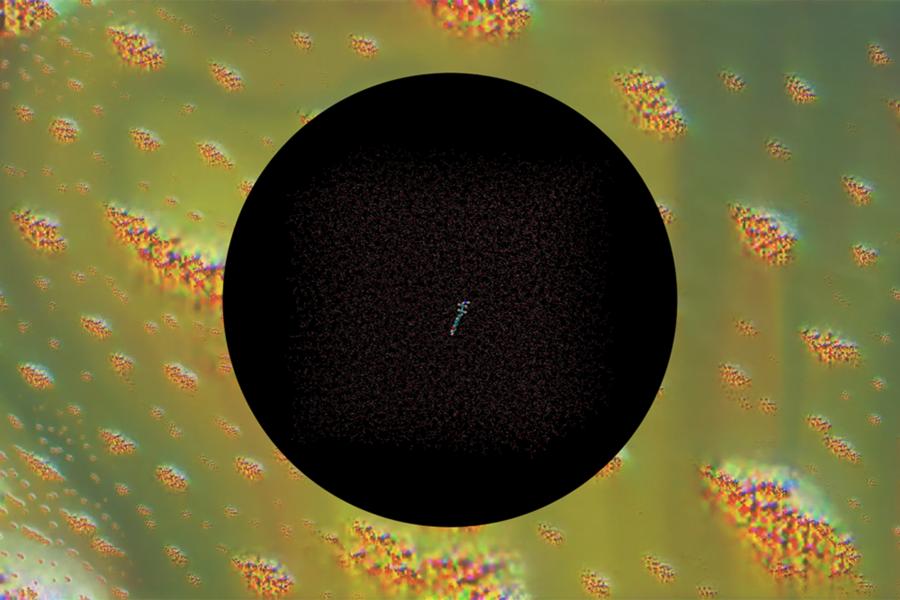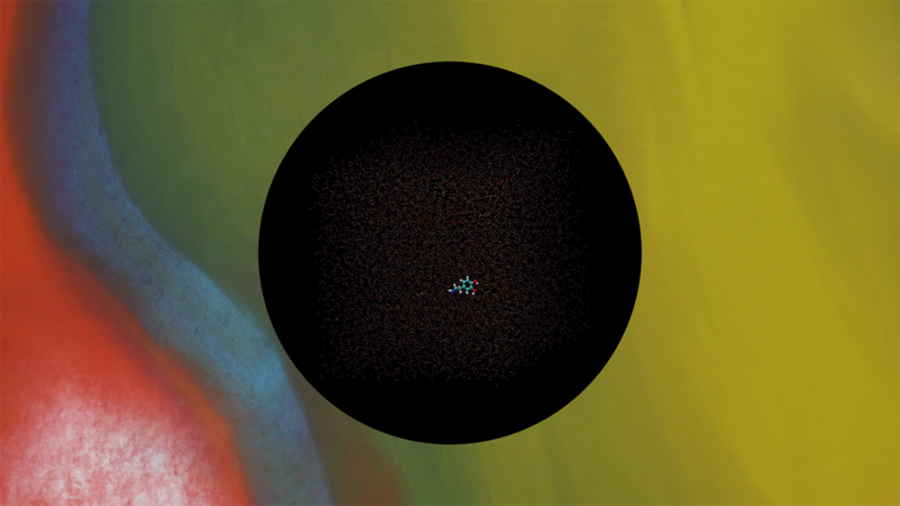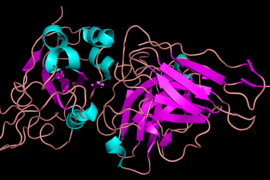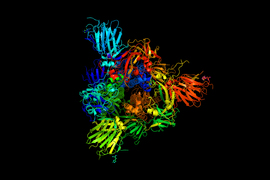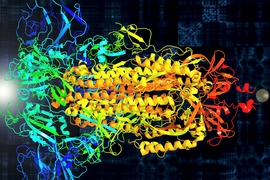In Jenna Sutela’s work, which ranges from computational poetry to experimental music to installations and performance, the MIT Center for Art, Science & Technology (CAST) Visiting Artist enlists microbes and neural networks as co-creators.
“I want to explore this notion of expanded authorship through bringing in beyond-human life forms,” Sutela says. Inspired by science fiction, she employs both nature’s oldest technologies — the slime model Physarum polycephalum that has been compared to a computer — and the newest ones developed in research labs. Bacteria and artificial intelligence are among her many collaborators in creating artworks that challenge the deeply ingrained idea that humans exist apart from the teeming, vibrating world that contains us.
In April, Sutela participated in an Open Systems panel, moderated by Caroline Jones, professor of history theory and criticism, as part of this year’s CAST symposium. “Jenna Sutela operates in the fluid spaces of artistic knowing, bridging vastly separated topics from the 'distributed intelligence' of slime mold to the 'alien intelligence' flowing into a Victorian trance medium,” Jones notes, “When I proposed her for a visiting artist residency, I knew she would thrive in the edgy MIT research labs.”
As a visiting artist, Sutela was inspired by the sonifications of Jerry McAfee (1940) Professor of Engineering Markus Buehler, which are created by translating the vibrations of protein chains into audible sound. This is a field that she has been following attentively: different (still niche) scientific practices of observing life by listening instead of only looking.
As part of this research, Buehler had recently sonified the molecular structure of the coronavirus. “Not only can phenomena within the structure of materials — such as the motion or folding of molecules — be heard and open a new way to understand nature, but it also expands our palette of musical composition,” Buehler says. “When used reversibly, they yield a systematic approach to design new matter, such as new protein molecules that emerge from this process, complementing what evolution produces.”
“A lot of my work consists of using microscopes and telescopes to communicate things that are beyond our ability to experience firsthand,” Sutela says. She has given a voice, or a hum, to Bacillus subtilis bacteria that thrive both in our guts and in outer space. With the pandemic introducing a profound new global anxiety, Sutela wondered if the surge of chemicals that cause emotions such as love or bonding — what are referred to as “emotive molecules” in the project — could similarly be translated into perceptible form.
Seeing like a machine
Meanwhile, Buehler had spent the past decade listening to proteins and using them as “instruments” and a source for auditory compositions. He had only lately turned to making these molecular patterns comprehensible to another human sense: sight. By hooking an actuator up to a petri dish of water, he was able to see how molecular vibrations manifested as visible water waves. “But when I looked at all these different patterns from different proteins and mutations and I couldn't really clearly distinguish them, I thought, ‘Maybe a machine learning algorithm might be able to do that, and help in the cross-domain translation,” he recalled.
The computer, with its artificial neural network, became a creative collaborator. “The computer has now understood the mechanisms of these vibrations and how they relate to different proteins, or molecules. Then I can actually take an image, and ask the algorithm, ‘What do you see in this picture?’” says Buehler. The computer then “draws” on the image, superimposing the patterns it detects on top of the picture to an almost psychedelic effect. In a photo taken of a recent trip to the seaside (like so many in quarantine, Buehler had found himself spending more time outdoors), he discovered the computer could pick out the invisible molecular patterns of the ocean and craggy rock.
This resonates with Sutela’s earlier machine learning-based work that has sought to “get in touch with the nonhuman condition of the computers that work as our interlocutors or infrastructure, or the computers even getting in touch with the more-than-human world around them.”
The oceanic
Could the computer detect a molecule of emotion? In short, could it see love? Buehler and postdoc Kai Guo from his lab at MIT conducted molecular dynamics modeling of the chemical structure of oxytocin, the hormone and neurotransmitter that is involved in childbirth and breast-feeding. He then translated this structure into vibrations, and taught the computer how to recognize them. “The human inspiration came in through Jenna,” he says.
She first emailed him a video of a quavering jellyfish, its translucent body indistinguishable from the surrounding sea. Then she began sending videos of wet-on-wet watercolor paintings that she had made as a form of lockdown meditation. This technique embraces unpredicatability by letting the flow of water determine the shapes on the wet paper. The sense of calm she experienced was subsequently reflected by the algorithm as it traced the forms of the neurotransmitters and other emotive molecules over the moving images.
Kai Guo created the molecular dynamics simulations shown in the video. “So, now you have the transcendence between the scales: the molecular, the quantum scale, to the audible scale to the visual scale, and then to the human,” says Buehler.
The video, titled “Wet-on-Wet,” will debut in an online exhibition, Survivance, organized by the Guggenheim Museum and the publishing platform e-flux. Sutela believes the idea of water, connecting humans to each other and the wider environment, dislodges assumptions about individualism. “There's this idea of oceanic feeling, a sense of oneness with the world, or this kind of limitlessness that's triggered by the oxytocin hormone,” Sutela says. “When talking about the oceanic, I'd like to focus on not just a feeling, but also work towards our responsibilities as part of both the ecosystem and the society.”
Finding a universal language
The way the SARS-Cov-2 virus has radically transformed the organization of our lives is evidence enough of the agency of nonhuman matter, and the ways in which the animate and inanimate are deeply enmeshed. “Wet-on-Wet” is, in a sense, an empathic overture to this more-than-human world, an attempt to find a common language in the form of waves, despite the limitations of our human senses.
The universe, we know, is always in motion, and each of us is vibrating matter. Sutela and Buehler’s work reminds us of our oneness based on this simple physical fact. As Caroline Jones notes, Sutela “helps us see the world as offering infinite kinship.”
Being able to visualize molecular vibrations may lead us to a greater appreciation of our interconnectedness across species, adds Buehler. The patterns of molecules that comprise a human body, after all, are similar to the patterns that might make up a rock, a jellyfish, or a piece of slime mold. “We live on a symbiotic planet,” says Sutela, “we’re part and parcel.”
